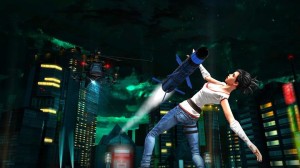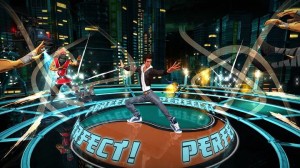Liverpool Sound and Vision Rating: 9 out of 10
Kick Beat: Special Edition is a unique combination of a music driven rhythm action fighting game available for download from the PlayStation Store for the PS4. The game is an enhanced adaptation of the PS3 and Vita versions of Kick Beat which was released in September 2013. Zen Studios being no strangers to delivering quality games, have also developed Planet Minigolf, CastleStorm and a variety of expansions for the amazing Zen Pinball series including Marvel Pinball and Star Wars Pinball as well as a range of individual themed tables.
It is most certainly best to start in the training mode as it will progressively teach everything the player needs to know about the game as it is split into three levels of training, basic, advanced and final. Each one goes into great detail of how to play and approach each area of the game, such as how to time the button presses in accordance with the music, how not to lose and replenish health.
The Story Mode consists of 24 songs in the tracklist for Lee’s story that must be completed by lasting the duration of the song without losing all of the available health. With each level being unlocked after being successfully completed and Mei’s story is unlocked after completing Lee’s story. Both stories are told through amazing artwork.
The Survival Mode provides players with multiple tracks blending from one into another, but it is a case of if the end is reached in time given the removal of the button prompts that previously would have helped to time the move, therefore resulting in players having to time their attacks by themselves without any help; whilst more enemies attack almost simultaneously forcing the reactions into having to be more precise.
The degree of success achieved after each level in every game mode is described by providing a score based upon a five star system that is related to how many yellow, blue and red enemies have been defeated as well as how many perfect hits have been achieved, out of the potential amount that could have been scored.
There are a number of basic rules and principles to follow during gameplay, this includes defeating as many consecutive enemies as possible to earn the best multiplier for a higher total score, while remembering to not randomly attack enemies before they have started attacking themselves or this will leave the character wide open to the next enemy and potentially in a position in which fatigue may momentarily set in. The character will lose health if enemies hit him or her, so it is important to time attacks with precision. The health of the character is displayed within the lower part of the yin yang that is situated on the floor of the location being fought fighting in. It is best to keep referring to it, if it depletes then the player will suffer a defeat and must begin the song from the beginning.
The other half of the yin yang displays the amount of chi possessed from defeating enemies and collecting chi orbs from certain enemies. It is important to keep an eye on that half of the yin yang too as it will begin to pulse as soon as the chi meter fills completely and any excessive chi earned beyond that will be lost. It is best to use it sooner rather than later in order to enter chi mode which will double the score multiplier throughout the duration of chi mode, although as is the case with the character’s health; chi can be lost by failing to counter an enemy attack. There are a number of power-ups available via collecting orbs from defeated enemies that can be collected to help progression through the track such as health, chi, points, score multiplier, shockwaves that can be activated to defeat nearby approaching enemies and a shield which is capable of making the character invulnerable for a short duration.
There is an extensive assortment of statistics from the total amount of time played; the amount of tracks completed as well as with full health and five stars; best combo chain; most perfect hits; total amount of each type of enemies hit; the longest survival streak; as well as the highest score, highest time, most defeated enemies of each enemy type and most perfect scores. The statistics are an excellent design choice due to how detailed they are and providing the player with the opportunity of analysing their own performance by checking how accurate their timing is based upon a best combo chain and the highest amount of perfect hits.
There is a range of unlockables including a music visualizer; a display of the trophy collection with a thorough description of how to obtain each trophy; cinematics from the progression of Lee’s and Mei’s stories with 12 story videos for each character totalling to 24; which is complimented by an entire host of rewards from costumes and outfits, alongside new game modes such as the music visualizer, free play mode, Mei’s story mode and even split-screen mode with detailed descriptions of how many stars have to be earned and of which type in order to unlock each available unlockable.
The level design comprises of a number of interesting and unique locations such as monasteries, wrestling arenas, dance clubs, Tokyo rooftops, Turkish baths and spheres which collectively provides such a diverse range of environments that helps the gameplay to remain fresh.
The character design includes two lead characters, Lee and Mei, who are both at the centre of their own stories, while there are three enemy types differentiated by their colour scheme including yellow enemies that attack individually, blue enemies that approach rapidly in quick succession and red enemies that attack simultaneously.
Kick Beat: Special Edition supports the share feature that allows players to upload a video clip to Facebook, Twitter or YouTube; upload a screen shot to Facebook or Twitter; and broadcast live gameplay footage via Twitch or Ustream as they are experiencing the game with a simple tap of the share button and selecting the option of choice. The PS4’s hard-drive continuously stores the most recent fifteen minutes of gameplay footage, so players still have the chance to decide if they would like to share something amazing a few minutes after it has taken place. The share feature is a next-gen revolution that has only improved with the further customisation provided by the Share Factory app that allows commentary, music, themes, stickers, effects, text, picture-in-picture video between the game footage and reaction from the PlayStation Camera and much more besides, which will only continue to prosper and flourish as it matures with additional features and further experimentation in the future. The Share Play feature provides a platform for a gamer that does not own the game to take control of the game started and invited that person to play, although it only lasts for one hour; it is a great service as it effectively presents a one hour demo of the game to anyone invited who does not own it, while being an excellent sociable feature too.
Kick Beat supports cross-buy between the Vita and PS3 versions, although unfortunately the same functionality has not been extended to the PS4 version and cross-save compatibility has not been implemented either. This means that if the game is already owned on the Vita and PS3 versions but would like to play the PS4 version then the player would have to purchase it again. As for the lack of cross-save resulting in players having to start the game from the beginning, a clear solution is to start from the beginning on PS4 but to continue progression on the Vita as the PS4 version of Kick Beat: Special Edition supports remote play resulting in being able to continue on playing the PS4 version anywhere desired to with the same save file during remote play.
The controls are well mapped to the DualShock 4 controller with the control scheme consists of pressing the appropriate combination of X, O, square or triangle or alternatively left, right, up or down on the d-pad to defeat the enemy that is approaching from the corresponding direction. Pressing L1 or L2 to activate chi; pressing R1 or R2 to activate power-ups; pressing the share button takes players to the share feature menu and pressing the options button to display the pause menu. The light bar remains red during gameplay, although the light bar would have perhaps been better utilised by producing a range of colours from green through yellow, orange, red and flashing red to display the status of the character’s health, while the DualShock 4 controller vibrates when the character has been hit by an enemy. There is no touch pad implementation which is surprising as the touch pad could have provided an alternative control scheme to the d-pad and face buttons in regards to tapping up, down, left or right or swiping in those directions on the touch pad to defeat the enemy that is about to attack.
The PS4 version is an improvement in comparison to the PS3 version as the PS4 version is 1080p and 60FPS, while the PS3 version is 720p and 60FPS with fluent character animations which is particularly important when the gameplay regularly includes such actions as martial arts moves.
The presentation of the game is solid with a great user interface across various menus such as the main menu, solo play, split screen, scoreboards, unlockables, options and gameplay menus with support for navigation via the left and right analogue sticks, directional pad and face buttons, although it does not include support for navigation via the touch pad. The background of the menu screens revolves around the lead male character Lee performing a variety of martial arts moves and warm up preparations as Japanese texts scroll across the background.
Both of the lead characters have their story narrated via exceptional performances from voice-over artists Todd Haberkorn as Lee. Mr. Haberkorn has previously voiced Yun in Super Street Fighter IV and Ultra Street Fighter IV as well as various characters in a number of videogames and cartoons such as Dragon Ball Z, Fullmetal Alchemist, Naruto: Shippuden and The Legend of Korra. Mei is voiced by Lauren Landa who has also voiced Litchi Faye Ling in Blazblue: Continuum Shift, Leixia in Soul Calibur V, Kasumi and Alpha-152 in Dead or Alive 5 and Phase-4 in Dead or Alive 5 Ultimate. Music plays a major part in the gameplay with a soundtrack of licensed music spanning a wide spectrum of genres from established music artists such as enV, Papa Roach, Pendulum, P.O.D., Rob Zombie and Southpaw Swagger. The menus have an oriental genre of music, while the sound effects include the landing of the punches and kicks on enemies and from enemies onto the character as well as applause when successfully completed a level. There is no DualShock 4 speaker implementation which is surprising as it could have produced voice-overs during the story cutscenes as well as sound effects or music during gameplay.
The trophy list includes 15 trophies with 13 bronze, 1 silver and 1 gold trophy. The majority of the trophies are certainly not easy as players have to be as precise as possible in the timing of their moves such as the Pure Perfection bronze trophy for completing a story track with only perfect hits on master difficulty; the All Day Long bronze trophy for surviving 18 tracks in a row in survival mode; the Its All in the Mind bronze trophy for reaching a combo chain of 500 on expert and master difficulty; the A True Master bronze trophy for completing all tracks with 5 stars on master difficulty; The Legend silver trophy for countering the incoming attacks of 50,000 enemies; and the Grandmaster gold trophy for unlocking all of the trophies. It is estimated that depending upon skill and a good trophy guide to provide some helpful tips that it would take between 15 to 25 hours to 100% the trophy list.
There are four difficulty levels including normal, hard, expert and master with the major differences between lower and higher difficulty levels being that enemies can be tied to high energy sections of musical instrumentation such as the vocals and guitars during higher difficulty levels; despite usually being tied to attacking the character upon the beat of the music. However, there are further elements to the difficulty such as multiple enemies attacking simultaneously or enemies that are highlighted in a white outline attacking on the half beat which provides a much greater variation to the times players will have to perform an action as it will not strictly necessarily be on the beat or against a single enemy.
The split-screen multiplayer closely reflects the single player gameplay, although it is naturally more fun with a greater sense of reward when more points are earned and generally better statistics than the opponent, however in order to unlock the split-screen multiplayer players are required to complete the helicopter boss fight which is situated on the sixteenth level of the story. This provides a major misstep as the split-screen multiplayer would have been much better suited to being unlocked after successfully completing the opening level of the story mode and being able to continue throughout the story levels during split-screen multiplayer without having to overcome so much of the game in single player before being allowed access to any of the multiplayer functionality.
The online leaderboards are focused on all time, survival, total and dojo rankings with overall, my score and friends filters with each leaderboard containing each player’s rank; name (PSN ID) and the amount of points accumulated with the positioning of each player based upon their total points scored for each particular song within the available collection of music.
The replayability stems from a number of areas including the story mode, free play and survival game modes as well as four difficulty levels, split-screen multiplayer for two players, competitive online leaderboards and plenty of unlockable content to reward continued play and progression through the game. However, for as much great content and replay value as the Special Edition possesses; it actually does away with arguably the best feature of the PS3 and Vita versions as the PS4 version does not include the ability to use the player’s own music catalogue to generate levels as the feature was not supported at the time of release on PS4.
Overall, Kick Beat: Special Edition is an improvement over the original version in regards to resolution and some new songs, although it is also a step backwards from the original release on PS3 and Vita as the ability to generate levels from a personal music catalogue is unfortunately not possible on PS4 upon the release of the Special Edition. If you are a fan of the rhythm action genre, then Kick Beat is certainly recommendable, although there are clear reasons to purchase the PS4 Special Edition and the cross-buy PS3 and Vita release.
Jason Bonnar
Analysis
- Title: Kick Beat: Special Edition
- Developer: Zen Studios
- Publisher: Zen Studios
- System: PS4
- Format: PSN Download
- Cross-Buy: No
- Cross-Play: No
- Players: 1-2 (Local Multiplayer)/Online Leaderboards
- Hard Drive Space Required: 915MB


